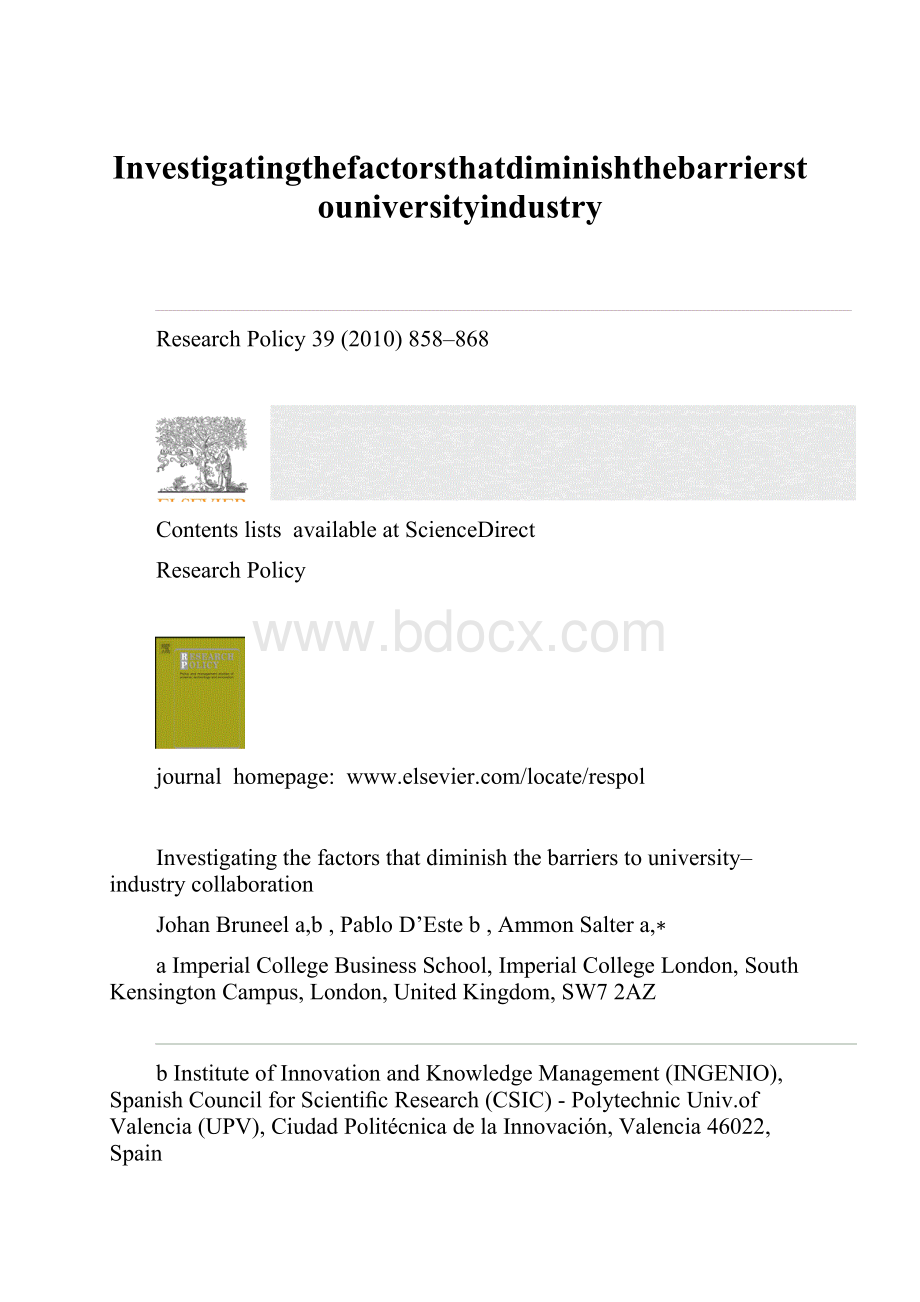Investigatingthefactorsthatdiminishthebarrierstouniversityindustry.docx
《Investigatingthefactorsthatdiminishthebarrierstouniversityindustry.docx》由会员分享,可在线阅读,更多相关《Investigatingthefactorsthatdiminishthebarrierstouniversityindustry.docx(45页珍藏版)》请在冰豆网上搜索。

Investigatingthefactorsthatdiminishthebarrierstouniversityindustry
ResearchPolicy39(2010)858–868
ContentslistsavailableatScienceDirect
ResearchPolicy
journalhomepage:
Investigatingthefactorsthatdiminishthebarrierstouniversity–industrycollaboration
JohanBruneela,b,PabloD’Esteb,AmmonSaltera,∗
aImperialCollegeBusinessSchool,ImperialCollegeLondon,SouthKensingtonCampus,London,UnitedKingdom,SW72AZ
bInstituteofInnovationandKnowledgeManagement(INGENIO),SpanishCouncilforScientificResearch(CSIC)-PolytechnicUniv.ofValencia(UPV),CiudadPolitécnicadelaInnovación,Valencia46022,Spain
articleinfo
abstract
Articlehistory:
Received11March2009
Receivedinrevisedform3November2009
Accepted26March2010
Availableonline11May2010
Keywords:
Universities
University–industrycollaboration
Barrierstocollaboration
Inter-organizationaltrust
Althoughtheliteratureonuniversity–industrylinkshasbeguntouncoverthereasonsfor,andtypesof,collaborationbetweenuniversitiesandbusinesses,itoffersrelativelylittleexplanationofwaystoreducethebarriersinthesecollaborations.Thispaperseekstounpackthenatureoftheobstaclestocollaborationsbetweenuniversitiesandindustry,exploringinfluenceofdifferentmechanismsinlow-eringbarriersrelatedtotheorientationofuniversitiesandtothetransactionsinvolvedinworkingwithuniversitypartners.Drawingonalarge-scalesurveyandpublicrecords,thispaperexplorestheeffectsofcollaborationexperience,breadthofinteraction,andinter-organizationaltrustonloweringdifferenttypesofbarriers.Theanalysisshowsthatpriorexperienceofcollaborativeresearchlowersorientation-relatedbarriersandthatgreaterlevelsoftrustreducebothtypesofbarriersstudied.Italsoindicatesthatbreadthofinteractiondiminishestheorientation-related,butincreasestransaction-relatedbarriers.Thepaperexplorestheimplicationsofthesefindingsforpoliciesaimedatfacilitatinguniversity–industrycollaboration.
©2010ElsevierB.V.Allrightsreserved.
1.Introduction
Collaborationbetweenindustryanduniversitiesfacessignifi-cantchallenges.Whileuniversitiesareprimarilydriventocreatenewknowledgeandtoeducate,privatefirmsarefocusedoncap-turingvaluableknowledgethatcanbeleveragedforcompetitiveadvantage(DasguptaandDavid,1994).Inaddition,universitiesarebecomingincreasinglyproactivemanagersoftheircollabora-tionswithindustry,seekingtocreatevaluableIntellectualProperty(IP)tofostertechnologytransfer.Accordingly,moreandmoreinteractionsbetweenuniversityandindustryarebecomingsub-jecttomeasurementandmanagement,leadingtomoreformal,contractualexchangesbasedoncodifiedrulesandregulations.Althoughboththeseaspectshavebeenacknowledgedintheliter-atureonuniversity–industry(U–I)linkages,relativelyfewstudieshaveinvestigatedthenatureofthebarriersandthefactorsthatmightmitigatethem(seealsoHalletal.,2001).GiventhecentralimportancegivenbypolicytobuildingandsupportingU–Ilinks,
∗Correspondingauthor.
E-mailaddresses:
j.bruneel@imperial.ac.uk,johan.bruneel@ugent.be(J.Bruneel),a.salter@imperial.ac.uk(A.Salter).
thelackofresearchontheobstaclestocollaborationisaserioushindrancetothedesignofeffectivepolicy.
Inordertoadvanceknowledgeinthisarea,thispaperexam-inestwotypesofbarriers:
(i)thoserelatedtodifferencesintheorientationsofindustryanduniversities,whatwedescribeas‘orientation-relatedbarriers’;and(ii)barriersrelatedtocon-flictsoverIP,anddealingwithuniversityadministration,whatwedescribeas‘transaction-relatedbarriers’.Thispaperexploresthemechanismsthatcanlowerthedegreetowhichfirmsencounterthesetypesofbarriersthroughanexaminationofthreeimportantelementsthatinfluencethefirm’sperceptionofthesetwosetsofobstaclestocollaboration.First,weexploretheimpactofthefirm’spriorexperienceofworkingonresearchprojectswithuniversitiesontheassumptionthatexperiencecaneasebothtypesofbarrierstocollaboration.Second,weexaminewhetherthenatureoftheinteractionbetweenthefirmanditsuniversitypartnerplaysaroleintheperceptionofbarriers.Inthiscase,weexpectthatfirmsthatarticulatetheircollaborationsthroughmultiplechannelswillper-ceivebarriersaslessconstraining.Wealsoinvestigatewhetherthenatureoftheinteraction–herewecontrasteducation-basedwithcontract-basedformsofinteraction–thatfirmsengageinwithuni-versitypartnerspositively(ornegatively)influencestheperceptionofdifferenttypesofbarriers.Finally,weassesshowtheleveloftrustinitsuniversitypartnersshapesthefirm’sperceptionofthebarrierstoworkingwithuniversities(Nooteboom,2002;McEvilyet
0048-7333/$–seefrontmatter©2010ElsevierB.V.Allrightsreserved.
doi:
10.1016/j.respol.2010.03.006
al.,2003).Ourapproachprovidesawindowonsomeofthemecha-nismsthatmaylimitthedepthandqualityofinteractionsbetweenuniversitiesandbusinesses.
Theanalysisisbasedonthestatisticalanalysisofalargesur-veyofUKfirmsthathavecollaboratedonpubliclyfundedresearchprojects,combinedwithdatafromrecordsofpriorinvolvementinresearchcollaborationwithuniversities.Theanalysisshowsthatpriorexperienceofcollaborativeresearchlowersorientation-relatedbarriersandthatgreaterlevelsoftrustreducebothtypesofbarriersstudied.Wealsofindthatbreadthofinteractiondiminishestheorientation-related,butincreasestransaction-relatedbarriers.Weexploretheimplicationsofthesefindingsforresearchandpol-icy.
2.BarriersassociatedwithU–Icollaboration
2.1.Incentivesandconflictsbetweenpublicandprivateknowledge
AtthecoreoftheobstaclestoU–Icollaborationsarethediffer-entinstitutionalnormsgoverningpublicandprivateknowledge(DasguptaandDavid,1994).TheuniversitysystemisrootedinMertoniannormsofscience,suchascommunalism,universalism,disinterestednessandorganizedscepticism(Merton,1973).Thecreationofreliableandpublicknowledgehasbeencentraltothegrowthoftheseorganizations,leadingtosupportfromgovernmentforresearchtoexpandthepoolofeconomicallyusefulknowledge(Geunaetal.,2003).Theseinstitutionalnormsarefundamentaltothewaythatmanyacademicsperceiveandperformtheirwork.Indeed,scientistsarewillingtoacceptlowerwagesinordertoworkwithintheinstitutionsofscience,indicatingthatmanyscientistsaremotivatedbyintrinsicgoalsaswellasthesocialobjectivesoftheuniversities(Stern,2004;CohenandSauermann,2007).Theinstitutionsofscienceincludestrongcompetitivemechanismsandpowerfulincentiveregimes.Thepriorityofestablishingreputationthroughpublicationiscriticaltoacademicsuccessand/orcareersustainability.Academicsoftenhavetoengagein‘statuscompeti-tions’withtheirpeers,basedonpublicationrecords,institutionalaffiliationsandprizes(Becher,1989).Manyofthesecompetitionstaketheformofwinner-takes-all,inwhichpublishingfirstorwinningthelargestresearchgrantsprecludesothersfromthesesameachievementsorresources.Giventhisenvironment,muchofthesciencesystemisdrivenbyinternaldynamicsthataresepa-ratefrommarkettransactions(Polanyi,1962;DasguptaandDavid,
1994;Stephan,1996).Peeresteemcannotbeboughtandmustbecreatedbywinningfavourandreputationamongcolleagues.
Althoughitmightbetemptingtoseethesciencesystemasoper-atingoutsidetheconfinesofmarkettransactions,itisalsotruethateconomicandsocialforcesoutsidethesciencesystemitselfplayapowerfulroleinshapingscientistsandscience(Freeman,1999).Muchoftheresearchsupportedbygovernmentisapplied,orprac-ticallyoriented,andfocusedonsolvinggeneralsocial,technicaloreconomicproblemsusingthecapabilitiesofscience(Pavitt,2001).Scientistsoftenholdconflictingandevolvingviewsonthebene-fitsofworkingwithindustry(Welshetal.,2008).Moreover,manyfieldsofresearch,suchasengineering,bytheirnature,involveconsiderableinteractionwithindustrialpractice(RosenbergandNelson,1994).Inaddition,theroleoftheuniversityasanedu-catorofprofessionals–doctors,engineers,accountants,lawyers,etc.–meansthatalargeproportionoftheirstaffarefocusedonfieldsofresearchthatengagewithpracticalproblems.Fortheresearchersworkinginsuchareas,practicalproblemsprovideapowerfulstimulustothedevelopmentofnewideas(Rosenberg,
2002).Althoughwithinthesepractical-orientedareasofresearchthenormsofsciencestilloperate,theydososomewhatdifferently
fromtheMertonianidealofscience.Researchersintheseareasaremorelikelytobeengagedonrealworldproblemsandinteractingwithindustry,andtheirstatusislikelytobeco-determinedbytheirreputationamongtheirpeersandtheirstandinginindustry.Thisisespeciallytrueinthecaseofengineering(Vincenti,1990).
Incontrasttotherelativelyopennatureofthesciencesystem,theprocessofknowledgecreationintheprivatesectorisdomi-natedbyattemptstoappropriatetheeconomicvalueofwhatfirmsknowinordertogaincompetitiveadvantage(Teece,1986).This
‘private’knowledgeislargelyclosed,remaininghiddenwithinthefirmordisclosedinalimitedwaythroughpatentsfiledprimarilyforthepurposesofobtainingtemporarymonopolies